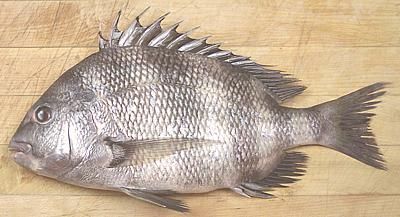 [family Sparidae]
[family Sparidae]
Porgies and Seabreams are deep bodied fish that subsist mainly by crushing shellfish and crustaceans. On the east coasts of North and South America the "Common Seabream", is the Red Porgy (Pagrus pagrus). Pagrus pagrus is also found on the coasts of southern Europe and North Africa, but the "Common Seabream" in Europe is the Blackspot Seabream (Pagellus bogaraveo). Here in California the familiar Porgies and Seabreams are all from Asia, Australia and New Zealand. Our Pacific Porgy (Calamus brachysomus) is not common in the markets.
More on Varieties of Fish
(very large page).
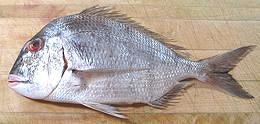 [Pink Porgy (Market), Japanese Seabream; Madal (Japan); Ch'amdom (Korea);
Pagrus Major]
[Pink Porgy (Market), Japanese Seabream; Madal (Japan); Ch'amdom (Korea);
Pagrus Major]
This is a very desirable eating fish. It is a West Pacific fish found
from northern Vietnam up the coast to southern Japan and Korea, but is
not found around the Philippines. It can grow to 39 inches, but is most
commonly around 12 inches. The photo specimen was 13-3/8 inches long and
weighed 1 pound 3-5/8 ounces. This fish is IUCN Red Listed as LC (Least
Concern). It is caught wild, but is also extensively farmed. This is the
second most heavily farmed fish in Japan.
Details and Cooking.
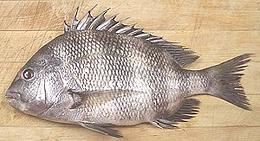 [Archosargus probatocephalus]
[Archosargus probatocephalus]
Found along the West Atlantic from Nova Scotia around along the
northern coast of the Gulf of Mexico, this fish is not found around
the Caribbean islands. It can grow to almost 36 inches and 21 pounds
but the photo specimen was 12-1/2 inches and weighed 1-1/2 pounds.
It's an ocean fish but it freely enters brackish water and
sometimes even fresh water. It is considered an excellent eating
fish and fished commercially, but is not threatened.
Details and Cooking.
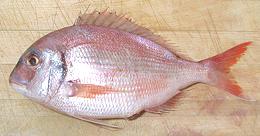 [Pink Snapper, New Zealand Snapper, Australian Snapper, Squirefish;
Pagrus auratus]
[Pink Snapper, New Zealand Snapper, Australian Snapper, Squirefish;
Pagrus auratus]
This Porgy is often sold in North America as "New Zealand Snapper" or
"Pink Snapper", though it isn't a snapper nor closely related to them.
It is found off the coasts of Australia and New Zealand. A distinctly
separate population is found from northern Vietnam to southern Japan.
Farming this fish is in the development stages (2015) so some market
fish may be farmed. This fish can reach 51 inches and 44 pounds, but is
more commonly around 16 inches. The photo specimen was 12 inches
long and weighed 1 pound 1 ounce. This fish is IUNC listed as DD
(Data Deficient), but is not considered threatened.
Caution: The name "Snapper" allows this fish to be sold at
a premium price, but it's not a snapper. It has very good flavor, but
has limitations that may make it not worth the price to you. For details
see
Details and Cooking.
 [Dorata (Spain); Orata (Italy); Dorade royale (France);
Sparus aurata of family Sparidae]
[Dorata (Spain); Orata (Italy); Dorade royale (France);
Sparus aurata of family Sparidae]
This fish is native to the Mediterranean, Black Sea and East Atlantic
from Morocco to southern Norway. It is considered a prize eating fish
throughout its range, and is now being farmed. The photo specimen was
12-3/4 inches long and weighed 1 pound 3-3/8 ounces.
Details and Cooking.
 [Acanthopagrus latus]
[Acanthopagrus latus]
This Indo-West Pacific fish is found from the Persian Gulf to the
Philippines and from the north coast of Australia to Japan. It can grow to
19 inches and 3 pounds but the photo specimen was 10-1/2 inches and
weighed 12 ounces. It is both caught wild and farmed.
Details and Cooking.
 [Silver Bass (suggested market name); Stenotomus chrysops]
[Silver Bass (suggested market name); Stenotomus chrysops]
This fish is found on the Eastern Seaboard of North America, from
Nova Scotia, Canada down to Florida USA, but is not common south of
North Carolina. It can grow to nearly 18 inches and a little over
4-1/2 pounds, but is commonly a around 10 inches and 1 pound. This
has long been held as a "trash fish", but is now getting some attention
in the seafood market due to declining availability of the more popular
fish. The flavor is light, and liked by many people, but it is not
suitable for wet cooking and is usually pan fried, broiled or baked,
often whole. Skin shrink is severe, so it must be slashed or removed for
cooking. Some is exported to Japan. It was considered overfished, but
regulations are in place and populations are recovering. It is IUCN
Red Listed NE (Not Evaluated).
Photo from 1902, copyright expired.
 [Red Bream, Red Seabream, Common Sea Bream (UK); Dorade Rose,
Pageot Rose (France); Borazo, Goraz (Spain); Goraz (Portugal);
Pagellus bogaraveo]
[Red Bream, Red Seabream, Common Sea Bream (UK); Dorade Rose,
Pageot Rose (France); Borazo, Goraz (Spain); Goraz (Portugal);
Pagellus bogaraveo]
This is a very important food fish in the Northeast Atlantic. It is found from the coast of Morocco into the western Mediterranean and north to Iceland and Norway, even into the Arctic Circle. It is particularly common around the British Isles and along the western coast of France. It can grow to nearly 28 inches and nearly 9 pounds, but is commonly about 12 inches long. This fish is sold fresh and frozen, to be pan fried, broiled or baked. It does not appear in the fish markets in Southern California, so I have no further information. Photo by Tamorlan (cropped, rotated and color corrected) distributed under license Creative Commons Attribution-ShareAlike v3.0 Unported.
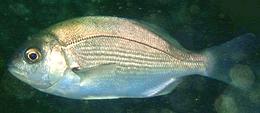 [Hottentot (Afrikaans); Pachymetopon blochii]
[Hottentot (Afrikaans); Pachymetopon blochii]
This fish, native to the west coast of South Africa north to Angola,
can grow to 18 inches and 3-3/4 pounds, but is more commonly 10 inches.
It was important to the early Dutch settlers in South Africa, and
to the Cape Malay who cooked a lot of fish dishes. It is still
fished commercially. IUCN Red List rated NE (Not Evaluated)
Photo by Peter Southwood distributed under license
Creative Commons
Attribution-ShareAlike v3.0 Unported.
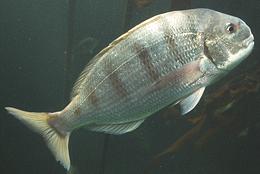 [Rhabdosargus globiceps]
[Rhabdosargus globiceps]
This fish, native to the coast of Namibia and South Africa around to
southern Mozambique, can grow to 25 inches, but is more
commonly 16 inches. It is a gamefish and minor commercial catch in
the region. It has traditionally been used by the Cape Malay.
IUCN Red List rated NE (Not Evaluated)
Photo by Brian Gratwicke distributed under license
Creative Commons
Attribution-ShareAlike v2.0 Generic.
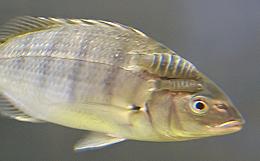 [Steenbras (Afrikaans); Lithognathus aureti]
[Steenbras (Afrikaans); Lithognathus aureti]
This fish, native to the west coast of South Africa north to Angola,
can grow to 39 inches and 42 pounds. In South Africa it is currently
restricted to recreational catch by persons holding a valid fishing
license and cannot be sold. It has traditionally been used by the
Cape Malay. The fish in the photo has been attached by two
parasitic isopods. IUCN Red List rated NE (Not Evaluated)
Photo by Hans Hillewaert distributed under license
Creative Commons
Attribution-ShareAlike v4.0 International.